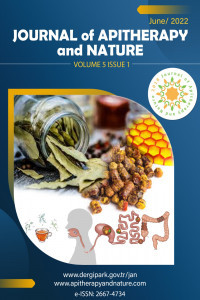Chemical Composition of Selected Propolis Samples from Kyrgyzstan and Kazakhstan
Chemical Composition of Selected Propolis Samples from Kyrgyzstan and Kazakhstan
Propolis (bee glue), Chemical Composition, Kazakhstan, Kyrgyzstan,
___
- 1. Popova Μ., Chinou Ι., Marekov Ι. and Bankova V. (2009). Terpenes with antimicrobial activity from Cretan propolis. Phytochemistry, 70: 1262-1271. 2. Bankova V., De Castro S.L., Marcucci M.C.: Apidologie 2000, 31, 3-15.
- Yayın Aralığı: Yılda 2 Sayı
- Başlangıç: 2018
- Yayıncı: Oktay YILDIZ
The Immune Modulatory and Anti-protozoal Effects of Different Propolis Samples
David G. WATSON, Harry de KONING, Godwin EBILOMA, John IgoLI, Weam SIHERI, Naif ALENZI, Samyah ALANAZI, Sameah ALENEZI, William HARNETT
Insights and Pitfalls in Propolis Research
Vassya BANKOVA, Milena POPOVA, Boryana TRUSHEVA
Hristo PETKOV, Boryana TRUSHEVA, Milena POPOVA, Vassya BANKOVA
“Green” Synthesis of Gold and Silver Nanoparticles with Propolis Extract and Rosa damascena Waste
Anton M. SLAVOV, Daniela KARASHANOVA, Biliana GEORGIEVA, İvelina VASILEVA, Vassya BANKOVA, Rada DINKOVA, Nikoleta YANTCHEVA
Muhammad IQBAL, Tai-ping FAN, David WATSON, Sameah ALENEZI, Muhamad SAHLAN
New Insights into Tropical Propolis: Propolis from Pitcairn Island
Boryana TRUSHEVA, Kristina GEORGIEVA, Milena POPOVA, Veselina UZUNOVA, Tihomira STOYANOVA, Violeta VALCHEVA, Rumiana TZONEVA, Vassya BANKOVA
Propolis from Romania and Turkey: Comparative Antioxidant and Antibacterial Activity
Otilia BOBIS, Merve KESKIN, Saban KESKIN, Sevgi KOLAYLI, Mihaela NICULAE, Adriana URCAN, Claudia PASCA, Liviu Al. MĂRGHITAS, Daniel S. DEZMIREAN
Determination of Propolis Origin Using Phenolic Composition and Artificial Neural Networks
İsabel REVILLA, Ana María VIVAR-QUINTANA, Pedro HERNÁNDEZ-RAMOS
Preliminary Evaluation of the Cytotoxic Potential of North-West Romanian Propolis
Constantin İ. MATES, Emoke PALL, Marina SPINU, Laura STAN, Mihaela NICULAE
Effect of Brazilian Propolis-containing Ointment on Genital Itching in Menopausal Women
Hiroshi MIURA, Yasuko MIURA, Yuki SHIMODA, Satoko KAGABU, Hiromitsu TSUBAKI, Yukihiro TERADA
